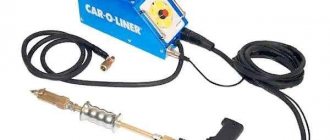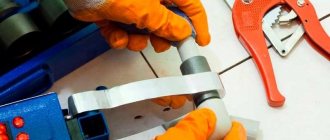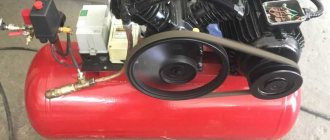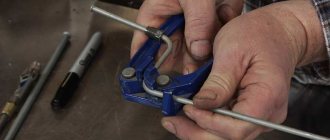Making homemade voltage stabilizers is a fairly common practice. However, for the most part, stabilizing electronic circuits are created that are designed for relatively low output voltages (5-36 volts) and relatively low powers. The devices are used as part of household equipment, nothing more.
We will tell you how to make a powerful voltage stabilizer with your own hands. The article we have proposed describes the process of manufacturing a device for working with a network voltage of 220 volts. Taking into account our advice, you can handle the assembly yourself without any problems.
How to make transformers T1 and T2?
The first transformer T1 with a power of 3 kW is manufactured using a magnetic core with a cross-sectional area (CSA) of 187 sq. mm. And three wires PEV-2:
- For the first wrapping, the PPS is only 0.003 square meters. mm. Number of turns – 8669;
- For the second and third windings, the PPS is only 0.027 sq. mm. The number of turns is 522 on each.
If you don’t want to wind the wire, then you can purchase two TPK-2-2×12V transformers and connect them in series, as in the figure below.
To make an autotransformer with a second power of 6 kW, you will need a toroidal magnetic core and PEV-2 wire, from which a wrap of 455 turns will be made. And here we need bends (7 pieces):
- Wrapping 1-3 bends from wire with PPS 7 sq. mm;
- Wrapping 4-7 bends from wire with PPS 254 sq. mm.
Taps are made on turns (counting from bottom to top): 203, 232, 266, 305, 348, 398. From the network, voltage should be supplied to turn No. 266.
How to make transformers T1 and T2?
The first transformer T1 with a power of 3 kW is manufactured using a magnetic core with a cross-sectional area (CSA) of 187 sq. mm. And three wires PEV-2:
- For the first wrapping, the PPS is only 0.003 square meters. mm. Number of turns – 8669;
- For the second and third windings, the PPS is only 0.027 sq. mm. The number of turns is 522 on each.
If you don’t want to wind the wire, then you can purchase two TPK-2-2×12V transformers and connect them in series, as in the figure below.
To make an autotransformer with a second power of 6 kW, you will need a toroidal magnetic core and PEV-2 wire, from which a wrap of 455 turns will be made. And here we need bends (7 pieces):
- Wrapping 1-3 bends from wire with PPS 7 sq. mm;
- Wrapping 4-7 bends from wire with PPS 254 sq. mm.
Taps are made on turns (counting from bottom to top): 203, 232, 266, 305, 348, 398. From the network, voltage should be supplied to turn No. 266.
Types of stabilizers
All industrial designs of such equipment can be divided into two large groups:
- electromechanical;
- pulsed.
Electromechanical
The operation of electromechanical devices is based on a servo drive, which is capable of changing the number of winding turns (and therefore the output voltage) by moving a conductive slider along a rheostat. Such devices are cheaper than all other models and have very good stabilization performance. However, they are more likely to break due to the presence of many mechanical parts.
But their main disadvantage is the response speed. Due to the fact that the drive does not move the current collector instantly, the stabilization delay can be up to 0.1 seconds, which is catastrophically long for devices that are sensitive to differences. In other words, such a stabilizer may simply not have time to protect modern electronics. In addition, due to the presence of mechanical parts, reproducing such a device at home is a non-trivial task.
Pulse
Stabilizers are called pulse stabilizers, the operation of which is based on the principle of accumulating current and distributing it to the consumer in fragments - pulses. These time intervals allow the system to accumulate the required current in the capacitors, and then provide stabilized power. Such devices also include devices whose operation is based on triacs and thyristors.
Such devices are more expensive than their electromechanical counterparts, but they are also much more reliable - there are no rubbing or moving parts, which means that, in fact, there is nothing to break. True, their stabilization indicators are worse - they are only capable of a proportional increase or decrease in input indicators. But the response speed is up to 20 milliseconds, and this is enough to protect even the most sensitive household electrical appliances. In addition, such a device can be assembled with your own hands, having the necessary skill and element base.
In addition to separation according to the principle of stabilization, there is a separation into single- and three-phase devices. But due to the fact that single-phase power is usually used at home, we do not take three-phase devices into account.
Types of modern devices
The development of semiconductor technology has made it possible to control power using radioelements with an efficiency of eighty percent. This made it possible to comfortably use them in a network with a voltage of 220 volts, without requiring large cooling systems. And the advent of integrated circuits made it possible to achieve miniature sizes of the entire regulator as a whole.
Currently, production produces the following types of devices:
- Phase. Used to control the brightness of incandescent or halogen lamps. Another name for them is dimmers.
- Thyristor. The operation is based on the use of a delay in switching on a thyristor switch during a half-cycle of alternating current.
- Triac. Power is regulated by changing the number of voltage half-cycles that act on the load.
- Travel regulator. Allows you to smoothly change the electrical power supplied to the electric motor.
In this case, the adjustment occurs regardless of the shape of the input signal. Based on their location, control devices are divided into portable and stationary. They can be carried out either in an independent housing or integrated into the equipment. The main parameters characterizing electrical energy regulators include:
- smooth adjustment;
- operating and peak power input;
- range of input operating signal;
- Efficiency
Thus, a modern electrical power regulator is an electronic circuit, the use of which allows you to control the amount of energy passed through it.
Thyristor control device
The operating principle of such a device is not particularly complicated. Basically, a thyristor converter is used to control low-power devices. A typical circuit of a thyristor power regulator consists directly of the thyristor itself, bipolar transistors and resistors that set their operating point, and a capacitor.
Transistors, operating in switching mode, generate a pulse signal. As soon as the voltage value on the capacitor is compared with the operating voltage, the transistors open. The signal is supplied to the control output of the thyristor, opening it too. The capacitor is discharged and the key is locked. This repeats in a cycle. The longer the delay, the less power goes to the load.
The advantage of this type of regulator is that it does not require adjustment, but the disadvantage is that it generates excessive heat. To combat overheating of the thyristor, an active or passive cooling system is used.
This type of regulator is used to convert power supplied to both household appliances (soldering iron, electric heater, spiral lamp) and industrial ones (soft start of powerful power plants). Switching circuits can be single-phase or three-phase. The most used: ku202n, VT151, 10RIA40M.
Triac power converter
A triac is a semiconductor device intended for use in an alternating current circuit. A distinctive feature of the device is that its terminals are not divided into anode and cathode. Unlike a thyristor, which passes current in only one direction, a triac conducts current in both directions . That is why it is used in AC networks.
An important difference between triac circuits and thyristor circuits is that there is no need for a rectifier device. The principle of operation is based on phase control, that is, on changing the opening moment of the triac relative to the transition of the alternating voltage through zero. This device allows you to control heaters, incandescent lamps, and electric motor speeds. The signal at the output of the triac has a sawtooth shape with a controlled pulse duration.
Independent production of this type of device is easier than thyristor one. Medium power triacs of the following types have gained wide popularity: BT137–600E, MAC97A6, MCR 22−6. The power regulator circuit based on a triac using such elements is characterized by ease of manufacture and no need for configuration.
Phase transformation method
The dimmer itself has a wide range of applications. One option for using it is to adjust the lighting intensity. The electrical circuit of the device is most often implemented on specialized microcontrollers that use a built-in electronic voltage reduction circuit in their operation. Because of this, dimmers are able to smoothly change power, but are sensitive to interference.
Read also: Operating principle of a screwdriver gearbox
Phase power regulators are not stabilized using zener diodes, but use thyristors operating in pairs as a stabilizer. The basis of their operation lies in changing the opening angle of the key thyristor, as a result of which the load receives signals with the initial part of the half-cycle cut off, reducing the effective voltage value. The disadvantages of dimmers include high ripple factor and low power factor of the output signal.
When dimmers operate in a wide range of frequencies, electromagnetic interference is generated. Such radiation leads to a decrease in efficiency due to the appearance of parasitic current in the conductors. To combat such currents, inductive-capacitive filters are added to the design.
Which is better: relay or triac
If we compare a triac stabilizer and a relay or thyristor stabilizer, then the first one is undoubtedly a more reliable, durable and safe device. This is explained by the absence of switches with moving contacts, the presence of a control board, a powerful autotransformer and power triac switches. The only drawback of triac stabilizers, compared to other devices, is their high cost, which over time justifies itself with a long service life and high reliability.
Thus, the device described in this article allows us to effectively deal with such a problem for many owners of apartments, country houses and country houses as voltage surges in the electrical network. The use of a stabilizer allows you to reduce to zero the risk of breakdown of electrical appliances and subsequent expensive repairs from short-term power surges in the network. The big difference in the price of such devices, compared to analogues, is several times less than the cost of repairing or purchasing new devices and equipment damaged by surges in unstable network electric current.
Advantages and disadvantages, differences from factory models
If we list the advantages of stabilizers made independently, the main advantage is low cost. Manufacturers of devices often inflate prices, and in any case, their own assembly will cost less.
Another advantage can be determined by such a factor as the ability to easily repair the device with your own hands. After all, who, if not you, knows better about a device assembled with your own hands.
In the event of a breakdown, the owner of the device will immediately find the faulty element and replace it with a new one. Easy replacement of parts is created by the fact that all parts were purchased in a store, so they can be easily purchased again at any store.
The disadvantage of a self-assembled voltage stabilizer is its complex configuration.
Assembly features of the device for voltage equalization
The current stabilizing device microcircuit is installed on a heat sink, for which an aluminum plate is suitable. Its area should not be less than 15 square meters. cm.
A heat sink with a cooling surface is also necessary for triacs. For all 7 elements, one heat sink with an area of at least 16 square meters is sufficient. dm.
In order for the AC voltage converter we manufacture to work, you will need a microcontroller. The KR1554LP5 microcircuit copes with its role perfectly.
You already know that you can find 9 flashing diodes in the circuit. All of them are located on it so that they fit into the holes that are on the front panel of the device. And if the stabilizer body does not allow their location, as in the diagram, then you can modify it so that the LEDs come out on the side that is convenient for you.
Now you know how to make a 220 volt voltage stabilizer. And if you have already had to do something similar before, then this work will not be difficult for you. As a result, you can save several thousand rubles on the purchase of an industrial stabilizer.
Let's start assembly
Since the most effective device is a triac device, let’s talk about how to make a similar stabilizer with your own hands.
It is important to emphasize that this type of model will be able to equalize the supplied current under the condition that the voltage is in the range of 130-270 V. Components will also be required. Tools you need are tweezers and a soldering iron.
Comments:
Cherevaty
Informative article, thank you. The diagrams are detailed and easy to read. There will be something to do on vacation. I want to throw such a stabilizer under a homemade wind station that powers a light bulb in a gazebo. Do you think the scheme will work?
Gaivoronsky
I assembled everything according to the diagram - everything works, thanks to the author. I will continue to experiment with a soldering iron and printed circuit boards.
Slavon
Uff... Does anyone know where all the parts can be bought? So that in one place you don’t have to overpay for the delivery of one relay, otherwise the stabilizer will turn out to be more expensive than a store-bought one
Alex
Slavon, yes, all these parts are sold on any piece of hardware. Don't bother. In any case, they are cheaper on the market, and you can buy used ones (but only if they are Soviet) - so in general the price turns out to be a pittance
Oleg Kyiv
The language of presentation certainly deserves special attention.
Vyacheslav
How were you able to repeat the design if there is no data on the magnetic circuit for the T2 transformer?
Sergey
How to convert the divider to a voltage of 100-250 volts?
Disadvantages of ET models offered on the market
Cheap models do not have special overload protection.
Despite the economical and well-developed design, electric power supplies have a number of disadvantages, which are usually classified as:
- lack of special overload protection in the simplest Chinese models;
- the resulting need for mandatory modification of the scheme;
- Many market samples do not have an input filter device, which forces them to add a smoothing electrolytic capacitor (it is placed after the “powerful” choke).
The listed disadvantages usually include the “hard” operating mode of high-voltage transistors connected according to a key circuit.
In the event of an accidental output short circuit (SC), these elements simply “burn out,” which leads to the need for an urgent update of the entire electronic module. Often, the rectifier based on semiconductor diodes also breaks down and also needs to be replaced.
ATmega32A-PU - stabilizer processor convenient for DIY installation
Why ATmega32A-PU?
Firstly, ATmega32 is the most popular among voltage regulator designers. 32 KB of memory and hardware is more than enough for all the necessary functions.
Secondly, the “PU” series has a large body, which is convenient when installing your product. It is difficult to solder contacts that are too small by hand. The processor cannot control the relay directly.
Firstly, the processor power supply is 5 Volts, and the relay needs 12. Secondly, the relay current is too high for the microcontroller pins.
To transmit control signals to the relay, Darlington transistors are used, more precisely a matrix of transistors in the form of a ULN2803A microcircuit. It is convenient to use a compact seven-sigment indicator to display information. Despite its small size, it will allow you to see the voltage value at a distance of up to 3 meters.
Manufacturing stages
To assemble a 220V voltage stabilizer for your home with your own hands, you first need to prepare a printed circuit board measuring 115x90 mm. It is made of foil fiberglass. The layout of the parts can be printed on a laser printer and transferred to the board using an iron.
Let's watch the video, a homemade simple device:
electrical circuit diagram
Next we move on to assembling the transformers. For one such element you will need:
- magnetic core with a cross-sectional area of 1.87 cm²;
- three PEV-2 cables.
The first wire is used to create one winding, and its diameter is 0.064 mm. The number of turns should be 8669.
The two remaining wires will be needed to make other windings. They differ from the first one in diameter being 0.185 mm. The number of turns for these windings will be 522.
If you want to simplify your task, you can use two ready-made TPK-2-2 12V transformers. They are connected in series.
In the case of making these parts yourself, after one of them is ready, they move on to creating the second. It will require a toroidal magnetic circuit. For the winding, choose the same PEV-2 as in the first case, only the number of turns will be 455.
Also in the second transformer you will have to make 7 taps. Moreover, for the first three, a wire with a diameter of 3 mm is used, and for the rest, buses with a cross-section of 18 mm² are used. This will help prevent the transformer from heating up during operation.
connection of two transformers
It is better to purchase all other components for a device you create yourself in a store. Once everything you need has been purchased, you can begin assembly. It is best to start by installing a microcircuit that acts as a controller on a heat sink, which is made of aluminum platinum with an area of more than 15 cm². Triacs are also mounted on it. Moreover, the heat sink on which they are supposed to be installed must have a cooling surface.
Next you need to install LEDs on the board. Moreover, it is better to choose blinking ones. If it is not possible to arrange them according to the diagram, then you can place them on the side where the printed conductors are located.
If assembling a 220V triac voltage stabilizer with your own hands seems complicated to you, then you can opt for a simpler linear model. It will have similar properties.
The effectiveness of a handmade product
What pushes a person to make this or that device? Most often - its high cost. And in this sense, a voltage stabilizer assembled with your own hands is, of course, superior to a factory model.
In addition, all the parts for such a device were previously purchased in the store, so if they fail, you can always find a similar one.
If we compare the reliability of a stabilizer assembled with our own hands and manufactured at an enterprise, then the advantage is on the side of factory models. At home, it is almost impossible to develop a model with high performance, since there is no special measuring equipment.
Conclusion
There are different types of voltage stabilizers, and some of them are quite possible to make with your own hands. But to do this, you will have to understand the nuances of the operation of the equipment, purchase the necessary components and carry out their proper installation. If you are not confident in your abilities, then the best option is to purchase a factory-made device. Such a stabilizer costs more, but the quality is significantly superior to models assembled independently.
Electromechanical (servo-drive) devices
The mains voltage is adjusted using a slider that moves along the winding. At the same time, different numbers of turns are used. We all studied at school, and some of us may have dealt with a rheostat in physics lessons.
An electromechanical voltage stabilizer works on this similar principle. Only the slider is moved not manually, but using an electric motor called a servo drive. It is simply necessary to know the structure of these devices if you want to make a 220V voltage stabilizer with your own hands according to the diagram.
Electromechanical devices are highly reliable and provide smooth voltage regulation. Characteristic advantages:
- Stabilizers work under any load.
- The resource is significantly greater than that of other analogues.
- Affordable cost (half lower than electronic devices)
Unfortunately, with all the advantages there are also disadvantages:
- Due to the mechanical design, the response delay is very noticeable.
- Such devices use carbon contacts, which are subject to natural wear and tear over time.
- The presence of noise during operation, although it is practically inaudible.
- Small operating range 140-260 V.
It is worth noting that, unlike the 220V inverter voltage stabilizer (you can make it with your own hands according to the circuit, despite the apparent difficulties), there is also a transformer. As for the operating principle, voltage analysis is performed by an electronic control unit. If it notices significant deviations from the nominal value, it sends a command to move the slider.
The current is adjusted by connecting more turns of the transformer. In case the device does not have time to react in a timely manner to excessive voltage, a relay is provided in the stabilizer device.
Connection errors
1
You may have everything connected perfectly and the diagram followed, but the stabilizer will constantly heat up and turn off, or errors will appear on its display.
Read in detail about where you can and where you should never place this device in the article “Where to install a voltage stabilizer in the house.”
2
Of course, this point can hardly be called a mistake. Moreover, 90% of consumers do just that.
However, this switch can really save your device from failure.
First you turn off the machines on the stabilizer panel.
Then move the switch itself to the TRANSIT or BYPASS position.
And only then turn on the machines again.
Many people forget about this and switch under load. Which ultimately leads to breakdowns.
With a 3-position automatic machine this is impossible. You automatically switch the voltage, without any manipulation on the stabilizer. And all this with one key!
There is no need to remember any sequence. So this procedure can be safely trusted to any family member.
3
You can choose a smaller cross-section only when powering individual electrical receivers.
If your whole house is sitting on a stabilizer, then please follow the input parameters according to the entire general house load.
4
For some reason, many people forget that often the entire load of your home passes through the stabilizer. Exactly the same as on the automatic input.
At the same time, in the electrical panel all the wires are crimped, even on light switches with minimal currents, but on the terminal blocks of the stabilizer or its circuit breakers, you can always find a bare wire simply pressed in with a screw.
Therefore, do not skimp and purchase the appropriate tips along with the device in advance.
5
Sometimes after connecting the stabilizer, the input machine starts to knock out. In this case, without a stabilizer, everything is fine and nothing is turned off.
Many people immediately blame it on an incorrect connection diagram or a defect in the device. They take it for warranty repairs, etc.
But the reason may be completely different. If your voltage is too low, 150-160V, then when you increase it to the standard 220-230V, the current in the network will increase significantly.
Hence all the problems
Please pay attention to this before you take it back to the store.
Sources - https://cable.ru, Kabel.RF
↑ Settings
Setting up the device consists of checking continuous switching and setting the rated voltage to 220 Volts using the construction resistor R15 and the SB1 button. It is necessary to apply voltage from LATR to the input through an incandescent lamp with a power of 100 - 150 W, set the voltage to 220 Volts and hold the button to achieve a green glow, rotating the construction resistor. After this, release the button, connect a voltmeter to the output of the device and, rotating the LATR, check the switching thresholds: lower 207 Volts and upper 232 Volts. In this case, the incandescent lamp should not flash or glow during switching, which indicates proper operation. Also, the operation of continuous switching can be seen on an oscilloscope; to do this, you need to connect an external trigger to the RC5 port and observe the output voltage of the stabilizer by changing the input voltage. During switching moments, the sine wave at the output should not be interrupted. When the output voltage is less than 187V, the red diode lights up and the green diode blinks. When the output voltage is greater than 242V, the blue diode lights up and the green diode blinks.
The stabilizer has been working for me for the 3rd month and has shown itself to be very good. Before this, I was using a stabilizer of a previous design, “Network voltage stabilizer on PIC12F675 (relay) 1.8 kW.” It worked well, but sometimes the computer's uninterruptible power supply would trip when it switched. With the new stabilizer, this problem disappeared forever.
Considering that the erosion of contacts in the relay has sharply decreased (there is practically no sparking), it would be possible to use less powerful relays as the main ones (LIMING JZC - 22F).
Determining the type of protection
Today, stabilizers are divided into 2 main types:
- stationary devices for voltage stabilization, their installation is done for the whole house;
- portable models, they can stabilize the operation of just a few electrical devices.
Also, stabilizers for stationary use are divided into single-phase and three-phase, it all depends on the conditions in which they are planned to be used. In your house or apartment, it would be more appropriate to install and connect a stabilizer near the electricity distribution board; with this step you can prevent failures and overloads of the entire network.
Automatic stabilizers "Ligao 220 V"
For alarm systems, a 220V voltage stabilizer is in demand. Its circuit is based on the operation of thyristors. These elements can only be used in semiconductor circuits. Today there are quite a few types of thyristors. According to the degree of security, they are divided into static and dynamic. The first type is used with electricity sources of various powers. In turn, dynamic thyristors have their limits.
If we talk about the voltage stabilizer (the diagram is shown below), then it contains an active element. To a greater extent, it is intended for the normal functioning of the regulator. It is a set of contacts that can connect. This is necessary in order to increase or decrease the maximum frequency in the system. Other models may have several thyristors. They are connected to each other using cathodes. As a result, the efficiency of the device can be significantly increased.
Choosing a voltage stabilizer for a computer
A computer consists of a system unit and a monitor. Therefore, the power must be summed up. Also, if the stabilizer also includes additional devices (scanner, printer, etc.), then all the power must be summed up and the resulting result compared with the range of ratings of the voltage stabilizers in question. As a rule, for a home computer you can choose a stabilizer with a power of no more than 1000 W.
For a computer, I also recommend using Smart UPS (interactive UPS) instead of a stabilizer. They contain a stabilization function (relay type) and have a battery. Thus, the voltage will be relatively stable and the reserve will be ensured.
Principle of operation
Such a stabilizing device works as follows:
- The voltage supplied to the device from the external network is measured by the control board (controller) using a special sensor;
- Based on the measurements obtained, the controller makes a decision to adjust the voltage;
- The controller sends the corresponding signal to the input triacs;
- Using the signal sent to the triacs by the controller, a voltage equalized to a certain value is supplied;
- Using an autotransformer located in the housing, the voltage supplied from the external network is equalized to the value necessary for the normal operation of electrical appliances.
This multi-step process takes a fraction of seconds. At the same time, unlike relay models, the presence of triacs makes it possible to turn on and off the transformer windings silently and very quickly.
Advantages of a household rectifier
By design and principle of operation, a double conversion stabilizer has a number of positive properties. A household inverter has the following qualities that affect the performance of the device:
- Extended input voltage indicator in the range of 115−300.
- Stabilization of the output voltage up to 220 V in case of a sharp current surge.
- Low noise threshold during operation of the device.
- Compact body dimensions and low weight.
- Filtering of high-frequency interference and emissions.
- Efficiency > 90%.
- Low accuracy of input voltage normalization.
- Operational regulation of electric current strength.
- Unpretentiousness to maintenance and operating conditions.
Advantages and disadvantages
The advantages of such a device include:
- High performance - the device, thanks to the presence of high-speed switching simulators, is able to respond very quickly to voltage surges in the network, smoothing them out to the required value;
- Wide range of input voltage - stabilizers of this type are capable of operating at input voltage values from 95 to 275 V (for a single-phase model), from 260 to 470-471 V (for three-phase stabilizers);
- High accuracy of stabilization - the output voltage produced by such devices has a maximum fluctuation within 1.5% (3.3-5.7 V), which does not have a negative impact on the operation of the devices connected to it.
- Monitoring the values of the input and output potential difference with an error of no more than 0.5%;
- High efficiency - thanks to the use of a triac, the value of this indicator for most models reaches 95-97%;
- Silence – the absence of relay switches and moving contacts in the design of the stabilizer allows it to operate almost silently;
- Small dimensions - stabilizers assembled on triacs, compared to relay ones, are small in size and can be compactly placed on the floor or wall of even the smallest room;
- Long service life - most modern high-quality models can normally perform their functions for 10 years or more;
- High power - various models are capable of ensuring normal operation of connected devices and equipment with a total power of 3 to 10 kW.
The disadvantages of such stabilizers include:
- High cost - high-quality models of stabilizers have a fairly high cost, which is not always affordable for many owners of apartments and houses.
- An abrupt change in the potential difference at the output of the device - this drawback is typical for inexpensive Chinese-made models. It practically does not appear in more expensive analogues.
On a note. Despite the high cost of such devices, their purchase in case of problems with the network voltage will be very profitable and will pay for itself quite quickly - if the stabilizer is missing, serious breakdowns of sensitive household appliances, pumping and heating equipment can occur. In some cases, such surges not only damage devices connected to the network, but also render them inoperable, which requires their replacement, leading to unplanned and significant financial expenses and other inconveniences.
How to calculate stabilizer power
To accurately determine the power of the converter, it is necessary to sum up the power of all equipment attributable to the rectifier and add 30% to the resulting sum so that there is a small power reserve. So, if the total power of all equipment in the house is 4 kW, you will need to connect a single-phase voltage stabilizer of 5 kW.
Each household appliance has power consumption information on the back panel. When calculating, you should use the starting power value. This value is determined as the product of the power of the device with an electric motor and the multiplicity factor.
Multiplicity factor for different household electrical appliances:
- refrigerator, automatic washing machine - 3-5;
- microwave, grinder - 2;
- air conditioners - 2-35;
- hammer drill - 3.
The stabilizer evens out fluctuations and differences in the electrical network, supplying consumers with a stable voltage of 220V
For example, the power when starting a microwave oven at 0.6 kW will be equal to 0.6x2 = 1.2 (kW).
Helpful advice! When calculating the power of the stabilizer, you need to take into account not the total starting power of all your existing household appliances, but choose the most powerful electrical equipment to connect through a rectifier. The power of the stabilizer is determined by the power of this device.
The stabilizer power is quicker and easier to calculate based on the power indicator of the machines installed in the panel. If the power of the machine is 25A and the mains voltage is 220V, the required active power of the stabilizer will be equal to 5500 W (25x220) or 5.5 kW. It is also worth considering the cross-section of the wire in the wiring: if the apartment is located in an old building, then the wiring in such houses has a cross-section of 4 mm² with a maximum current of 32A and there is no point in installing a powerful rectifier. For new houses, a 20 kVA stabilizer will be relevant. Such equipment can protect household appliances from short circuits.
The required stabilizer power can be calculated based on the power indicator of the machines installed in the panel
Additional functions of voltage stabilizers
In addition to the main function of voltage stabilizers - stabilization, there is also the following minimum set of functions and parameters:
Maybe this will be interesting too?
- Output voltage analysis. The stabilizer must be equipped with an information (digital or pointer) display that shows the output voltage. If the stabilizer has an input voltage analysis function, this will be additional useful information.
- At higher ratings (usually from 3000 VA), the “Bypass” function is installed - a function in an electronic device (signal processing, voltage stabilization, etc.) that allows you to switch the input signal directly to the output, bypassing all functional blocks. That is, the ability to turn on the network bypassing the voltage stabilizer. If the voltage has returned to normal or you do not need a stabilizer now, press the lever up and the voltage goes bypassing the stabilization blocks.
- Types of fastening of voltage stabilizers There are two types of fastening of voltage stabilizers - floor and wall versions. Floor-standing design means that the stabilizer is located on the floor or shelf. This arrangement is not always convenient, because especially large denominations cannot be placed on a shelf due to their weight, and they occupy quite large areas on the floor. When mounted, the stabilizers are made flatter for the convenience of customers. In principle, they can also be used in a floor-standing version, only often the information part of the display is in this case “upside down” towards the user.
- Many models on the voltage stabilizer market use a delay button. This is done so that if the voltage in the network disappears or temporarily goes beyond the operating range, the equipment will come to a rest position during this delay time before the next turn on. In many stabilizers, the delay button is offered in several ranges -6, 90, 120 sec. In more modern models, the delay has already become automatic and when it is turned on, it shows the consumer on the display the time the stabilizer is turned on in the form of a countdown.
Adjusting the camera's inertial image stabilizer
If you are using weights, the position of the center of gravity of which cannot be changed (as in the photo), then you can adjust the horizon by turning the vertical bar at a small angle at its attachment point. Before adjustment, one of the screws is loosened, and the second is not fully tightened. After which, the bar is installed in the desired position, and both screws are tightened.
If the camera does not have an electronic level indicator, an external bubble level can be used to adjust the horizontal position of the camera.
If you refuse to install a quick-release platform and use a standard photo screw, then such a stabilizer can be made in a couple of hours.
Here's an idea on how to raise the photo screw from a flash above the horizontal bar. I used this solution here a long time ago>>>
Assembly features of the device for voltage equalization
The current stabilizing device microcircuit is installed on a heat sink, for which an aluminum plate is suitable. Its area should not be less than 15 square meters. cm.
A heat sink with a cooling surface is also necessary for triacs. For all 7 elements, one heat sink with an area of at least 16 square meters is sufficient. dm.
In order for the AC voltage converter we manufacture to work, you will need a microcontroller. The KR1554LP5 microcircuit copes with its role perfectly.
You already know that you can find 9 flashing diodes in the circuit. All of them are located on it so that they fit into the holes that are on the front panel of the device. And if the stabilizer body does not allow their location, as in the diagram, then you can modify it so that the LEDs come out on the side that is convenient for you.
Now you know how to make a 220 volt voltage stabilizer. And if you have already had to do something similar before, then this work will not be difficult for you. As a result, you can save several thousand rubles on the purchase of an industrial stabilizer.
Subtleties of adjustment
The need for a voltage regulator will be in the following conditions:
- Adjustment of alternating and direct voltage is necessary.
- Ability to regulate load voltage.
Each listed item defines its own set of radio components in the circuit. But the device of the simplest regulator is based on a variable resistor. When adjusting AC voltage, no distortion is created. With the help of variable resistance it is possible to regulate direct current.
To ensure that the voltage and current load are of a given parameter, stabilizers are used. The output voltage is checked to the correct value, and if small specified changes occur, the regulator automatically resets.
You can find many step-by-step instructions on how to make a voltage regulator. But the simplest and most understandable option is considered to be a device based on integrated circuits. The convenience of the products allows you to power LEDs and other lighting systems in the car. The network regulator requires a step-down converter, and a rectifier should be connected to the input.
Very often the load can have different parameters, so for such cases it is impossible to do without special voltage stabilizers. Their work can be carried out in several modes.
For all electronic devices, it is important to obtain a stable voltage. They have non-linear components built into the electrical circuit.
There is a voltage regulator based on a thyristor. This is a very powerful semiconductor, which is used in high-power converter devices. Thanks to its specific control, it is used for “recess” switching.
Operation of the Suntek electromechanical stabilizer
To change the input voltage, an autotransformer is used, which can change the voltage within the required limits. In this case, the voltage at the output of the stabilizer does not go beyond the operating range.
In rural areas, for the safe use of household appliances, a single-phase 220V voltage stabilizer is required, which, in the event of a strong voltage drop in the network, maintains a rated output voltage of 220 volts at the output.
The electrical design has three threshold blocks, built on the principle of a voltage divider, consisting of resistances (R2-VD1-R1, VD5-R3-R6, R5-VD6-R6). In addition, the circuit uses two transistor switches VT1 and VT2 that control relays K1 and K2.
Diodes VD2 and VD3, together with filter capacitance C2, constitute the power source for the entire device. Capacitors C1 and C3 are used to absorb small voltage sags in the AC network. Capacitance C4 and resistor R4 are spark arresting components. To reduce self-induction voltage surges, two semiconductor diodes VD4 and VD7 are introduced into the circuit in the relay windings.
If the network voltage drops below 185 volts, then the relay contacts are turned on as in the diagram. The load voltage will be the sum of the mains voltage plus the voltage boost received from windings II and III of transformer T1.
If the voltage is in the range of 185-205 volts, then the zener diode VD5 is open. Current flows through relay K1, VD5 and resistors R3 and R6. But this current is not enough to trigger relay K1. Due to the voltage drop across resistor R6, VT2 opens. This transistor triggers relay K2 which, with its contacts, switches winding II (voltage booster).
If the network voltage is normal 205-225 volts, then the zener diode VD3 is open. This leads to the opening of VT1, so the second threshold block and VT2 are turned off along with relay K2. But K1 is triggered and with its contacts turns off windings II and III, and therefore the output voltage corresponds to the input.
When the mains voltage level increases above 225 but below 245 volts, the zener diode VD6 opens, opening both. Both relays are activated by winding III T1, connected in antiphase with the mains voltage (i.e. subtracted)). The output will have a normal alternating voltage in the range of 205-225 volts.
Inverter technology
A distinctive feature of such devices is the absence of a transformer in the design of the device. However, voltage regulation is carried out electronically, and therefore it belongs to the previous type, but is, as it were, a separate class.
If you want to make a homemade 220V voltage stabilizer, the circuit of which is not difficult to obtain, then it is better to choose inverter technology. After all, the principle of operation itself is interesting here. Inverter stabilizers are equipped with double filters, which allows minimizing voltage deviations from the nominal value within 0.5%. The current entering the device is converted into direct voltage, passes through the entire device, and before exiting it again takes on its previous form.
Homemade apparatus
A high-quality stabilizer for several kW and an output current of more than 10 amperes can be assembled based on an old transformer installed in a welding machine. However, such a “blank” is not easy to find. Moreover, the current technology is suitable for subsequent use for its intended purpose. For reproduction at home without professional skills, the circuit presented below on electronic components is suitable. It will provide:
- prompt correction of output parameters with a switching speed of no more than 8-12 milliseconds;
- operating input voltage range 125-265 V;
- power of connected consumers up to 5.5 kW.
Electrical and wiring diagram, printed circuit board
Advantages of a homemade device
In addition to good technical parameters, the following advantages should be noted:
- reasonable costs;
- the ability to independently perform repair operations.
Flaws
The consumer parameters of the product largely depend on the assembly. In this case, it is assumed that there are no well-developed skills and professional installation (measuring) equipment. On the other hand, careful execution of individual work operations will help control quality more thoroughly than the actions of third-party contractors.
Differences from factory models
Modern production is characterized by a high level of automation. This reduces the harmful influence of the “human factor” and reduces costs. With the use of professional technologies it is easier to ensure a perfect appearance. However, when creating a homemade product, you can use unique technical and aesthetic solutions.
Accessories
Main components (functional components):
- transformer power supply with diode temperature compensation and comparator;
- rectifier with divider;
- transistor load connection delay circuit;
- controller on digital chips;
- LED indication of operating modes and emergency situations;
- keys from optitron pairs.
Features of home production
Standard transformers TPK-2-2x12V are suitable. If necessary, you can create analogs with your own hands, using PEVs with a conductor diameter of 0.064 mm (8669 turns) and 0.185 mm (522 turns) in the primary and secondary windings, respectively.
Principle of operation
How does our network voltage stabilizer, which is easy to make with your own hands, work?
After the power is turned on, capacitor C1 is in a discharged state, transistor VT2 is open, and VT2 is closed. Transistor VT3 is also closed. It is through it that current will be supplied to each LED and triac optotron.
Since this transistor is off, the LEDs are not lit, each triac is off, and the load is off. At this time, electric current passes through resistor R1 and enters C1. Next, this capacitor is charged.
The delay interval lasts only three seconds. During this time, all transient processes are carried out, and after completion, the Schmitt trigger is triggered, the basis of which is transistors VT1 and VT2.
Next, the third transistor opens and the load is turned on.
The voltage that comes out from the third winding T1 is rectified by the diode VD2 and capacitor C2. Next, the current passes through the divider R13…14. From R14, a voltage whose level is proportional to the number of volts in the network is included in each non-inverting input of the comparators.
The number of comparators is eight and they are all located on chips DA2 and DA3. At the same moment, a constant reference current enters the inverting input of each comparator. It is supplied by resistor dividers R15…23.
After this, the controller comes into play, which processes the signal at the input of each comparator.
↑ Schematic diagram
It consists of an autotransformer switched both at the input and output using a relay. The circuit uses direct measurement of alternating voltage by a microcontroller. Output voltage through divider R13, R14, R15, R16
is supplied to the input of the microcontroller through capacitor
C10
.
The relay and microcircuit are powered through diode D3
and microcircuit
U1
.
Button SB1
together with resistor
R1
are used to calibrate the stabilizer.
Transistors Q1-Q4
are amplifiers for relays.
Relays P1 and P2 are the main ones, and relays P1a and P2a, together with diodes D1 and D5, close the circuit when switching the main relays. To reduce the relay turn-off time in relay amplifiers, BF422
and the relay windings are shunted with
1N4007
and 150 Volt Zener diodes connected back to back. To reduce impulse noise coming from the network, capacitors C1 and C11 are installed at the input and output of the stabilizer. A three-color LED indicates voltage levels at the stabilizer input: red – low, green – normal, blue – high.











